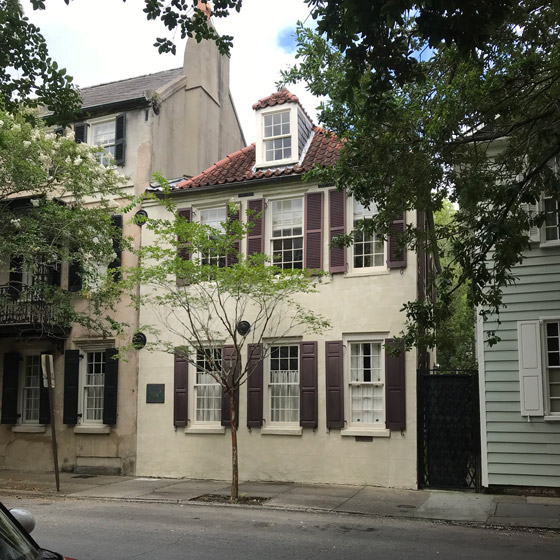
76 Church Street – DuBose Heyward House
76 Church Street was built around 1785 and appears small and charming, which I’m sure it was when DuBose Heyward, Charleston native and author of the novel Porgy, lived there between 1919 and 1924. I would imagine Heyward had seen various vegetable and seafood vendors with their carts throughout the residential sections of Charleston, but it was Sammy Smalls, a crippled black man with a goat cart, hawking his produce that provided the inspiration for Heyward’s protagonist. Sammy will live forever, thanks to DuBose Heyward, his wife, Dorothy who helped him adapt Porgy into a Broadway play and George Gershwin, who stayed at Folly Beach and wrote the grand lyrics to the famous American folk opera, Porgy and Bess.
Walking down Church Street, 76 Church is hard to miss with its red pantile tile roof and single dormer. This house is what we artists call “picturesque”. However, if you look at the photograph, something important is missing. Where is the front door? Originally the door was located in place of one of the three first floor windows. Now the entry is next door at 78 Church Street; in the mid-twentieth century both properties were purchased and remodeled into one single-family residence. The interior wall between the two houses was torn down, making one long room across the front and a large bedroom on the second floor.
Known as 76-78 Church Street, the exteriors of the buildings are so different that most people assume they are different structures (until they realize there is no door at 76 Church). They have different shutters; black for 78 Church, a warm reddish brown for 76 Church. 78 Church has a cast iron balcony and is taller with a full third floor. 76 Church is two and a half stories. I so appreciate the owners for preserving the integrity of both exteriors.
In 1920, many of the tenements across the street and north of 76 Church were dilapidated, overflowing with the poor who attempted to grow cabbages on the window sills. “Cabbage Row” was used to describe this area, and Heyward took the term “Cabbage Row”, changed it to “Catfish Row” and moved the scene one block over to East Bay Street. As a result, the Charleston scenes of the opera depict the area behind Rainbow Row as the backdrop.
Porgy and Bess was first performed in Boston in 1935. After several failed attempts, the opera was first produced in Charleston at the old Gaillard Auditorium in 1970. I was there, and it was an experience I’ll never forget.
Next week we will continue exploring Charleston history through her structures.



